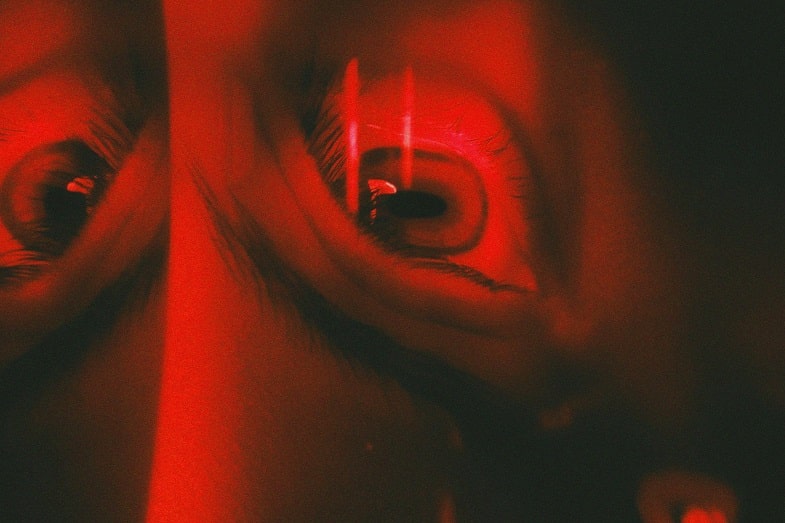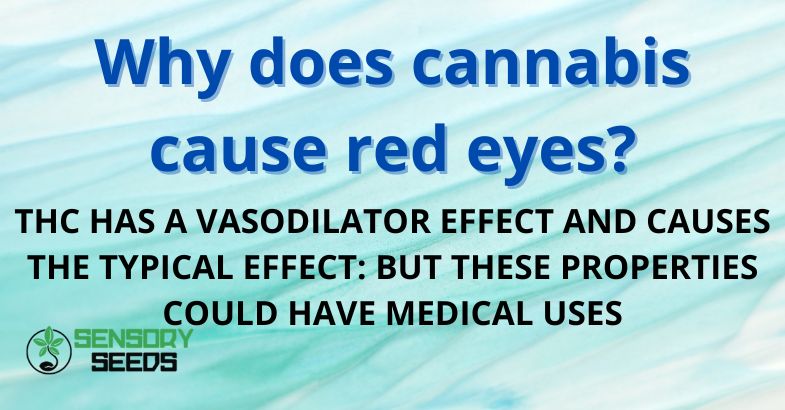Published on: 25/02/2024
THC HAS A VASODILATOR EFFECT AND CAUSES THE TYPICAL EFFECT: BUT THESE PROPERTIES COULD HAVE MEDICAL USES
A common phenomenon related to the use of cannabis is redness of the eyes: not surprisingly, the cannabis user is often represented with conspicuously red eyes, a detail which, in addition to being a tangible sign of consumption, raises some questions on the body’s physiological reactions to the substance.
In this article we will try to understand why cannabis causes redness of the eyes, how the active ingredient, tetrahydrocannabinol (THC), interacts with the body system, and how other variables can contribute to redness of the eyes.
Do your eyes get red? THC’s fault
Tetrahydrocannabinol (THC), the main psychoactive compound in cannabis, is the main cause of red eyes. In fact, this substance binds to cannabinoid receptors, mainly CB1 and CB2, widespread in the central nervous system and in other parts of the body, including the eyes.
One of the most direct effects of THC is its ability to reduce blood pressure: the drop in blood pressure causes the blood vessels to dilate (vasodilation), which in turn causes an increase in blood flow, especially in the smaller and more superficial capillaries of the eye.
This vasodilatory reaction is a consequence of THC entering the bloodstream, regardless of the method of intake, whether by inhalation, ingestion or vaporization: the phenomenon can vary in intensity from individual to individual depending on the different sensitivity to THC.
The vasodilatory effect of THC has attracted interest in the field of medical research, especially for treating glaucoma, a disease that causes excessively high eye pressure. The use of cannabis in this context is still the subject of studies and debates, especially because the vasodilatory effect of THC is temporary.
The relationship between tetrahydrocannabinol and eye redness is an example of how cannabis components can affect not only the mind, but also the body, in ways that could have medical applications.
Read also: THC and CBD Microdosing: everything you need to know
Red eyes: is it just because of THC?
In addition to the direct effects of THC, there are other factors that can cause redness of the eyes when consuming cannabis.
First of all, individual sensitivity to smoking plays a significant role. Cannabis smoke, like any other smoke, can irritate the eyes, especially in closed or poorly ventilated environments.
Furthermore, some people may be allergic to cannabis, although it is not that common: it is possible that, due to a specific sensitivity to the plant, you experience symptoms such as swelling, itching and, indeed, red eyes as part of an allergic reaction.
The method of taking cannabis, however, does not affect the redness of the eyes: the reaction can also occur with other forms of consumption, such as ingestion or vaporization.
In short, THC is a key factor in eye redness, but some individual and environmental variables that can accentuate this type of reaction must also be taken into consideration.


Cannabis consumption: effects on visual perception
Talking about redness of the eyes, can cannabis also have consequences on vision? Let’s talk about an interesting question, a question that concerns the impact of the substance on the human organism. THC can not only make the eyes red, but also affect the individual’s visual perception.
One of the best known side effects is the alteration in color perception. Some cannabis users see brighter colors or slightly distorted visual perception: this can be attributed to THC’s interaction with receptors in the brain, which affects how we process visual information.
Another interesting effect concerns visual acuity. It is not common, but some individuals report experiencing a temporary increase in this parameter after consuming cannabis.
In addition to the effects on color perception and visual acuity, the use of cannabis can lead to miosis, or contraction of the pupils, which can influence their reactivity to changes in brightness, a determining factor for vision in different light conditions
These side effects, although not so serious, deserve attention, especially for people who, for work or daily activities, need to see clearly. Understanding how cannabis affects visual perception and ocular health can help consumers make informed decisions about the effects of consumption.
How to treat eye redness due to cannabis use?
A common and immediate method is the use of eye drops with vasoconstrictor active ingredients, which work by temporarily narrowing the blood vessels in the eye, thus reducing redness. However, these products must be used with a certain moderation: excess can lead to eye irritation or even dependence on the product.
An alternative is represented by artificial tears, generally less aggressive for the eyes than “medicinal” eye drops and which therefore can be used frequently without too many problems. Artificial tears help hydrate and soothe dry eyes, a common effect after cannabis use.
In addition to pharmaceutical products, there are some daily practices that can help prevent red eye from being noticed. Wearing sunglasses can be an easy way to cover your eyes in public, while applying a cold compress can reduce redness by acting on vasodilation.
It is also essential to hydrate. Drinking sufficient water can not only help prevent redness of the eyes, but can also mitigate other side effects such as dry mouth.
While red eyes can be an embarrassing side effect of cannabis use, there are several effective and safe methods to manage it. The choice of treatment depends on individual preferences and personal sensitivity.
Eye redness due to cannabis: some medical considerations
Given that this article is neither intended to encourage the consumption of cannabis nor to give medical indications, which is only the responsibility of medical professionals, it is good to be aware that the effects of the substance on ocular health go beyond the simple annoyance of redness of the eyes. From a health perspective, it is critical to recognize both the potential benefits and risks associated with cannabis use, especially in relation to eye health.
As mentioned, research is evaluating the potential of cannabis in the treatment of glaucoma, a condition that involves an increase in intraocular pressure, potentially harmful to the optic nerve and which can lead to vision loss. Initial studies suggest that THC can help reduce this pressure: for example, a 2020 research by researcher Gemma Caterian Maria Rossi gave promising results on the combined use of THC, CBD and CBG.
However, it is important to note that cannabis is not currently considered a standard treatment for glaucoma, mainly due to the need for constant reduction of intraocular pressure, which this plant cannot consistently provide.
Beyond glaucoma, research is exploring how cannabinoids can influence other eye conditions and conditions. These studies are still in the early stages, but indicate the potential for further therapeutic applications.
On the other hand, those who consume cannabis should be aware of the possible risks, even beyond the strictly legal scope (given that its consumption constitutes an illicit act). Frequent use and in large quantities may have effects on long-term eye health that are not yet fully understood, and if you have eye conditions you should consult a doctor before using legal cannabis.
Cannabis undoubtedly has medical potential, but a balanced approach is needed that considers both the potential benefits and risks. Continued research is essential to fully understand the impact of cannabis on ocular health and its possible therapeutic applications.
Read also: Curiosities, myths and unsuspected truths about cannabis that you absolutely need to know


Cannabis consumption and laws: pay attention to regulations
The consumption of cannabis, in many countries, is prohibited or strictly regulated, and its use, both recreational and medical, is subject to severe restrictions.
In these cases, eye redness is not only a physical or health problem, but can also have legal and social implications. The presence of red eyes in individuals who have consumed cannabis can lead to possible legal consequences, especially in countries where cannabis consumption is strictly prohibited.
On the other hand, in some countries and regions there has been a movement towards legalization or decriminalization of the use of cannabis, especially for medical purposes: specific regulations regulate the production, distribution and consumption of cannabis, often with a focus on its therapeutic use for conditions such as chronic pain, multiple sclerosis, refractory epilepsy and, in some cases, glaucoma. The laws in these countries provide a framework for the safe and regulated use of cannabis.
Even in countries where cannabis is legal, both for medical and recreational use, regulations can vary and regulate, in a more or less stringent way, access, distribution and consumption. Those who consume it must therefore be aware of local laws and any restrictions.As regards cannabis seeds, in the UK it is only allowed for collecting purposes or for the preservation of genetics. On the other hand, making them germinate is strictly prohibited as it would constitute the crime of cultivating narcotic substances.
In conclusion
In this article, we explored the complex interactions between cannabis use and its effects on the eyes, a topic that extends far beyond simple “redness.” We have seen what role THC plays, the various causes that can contribute to eye redness, the effects on visual perception and how to treat the effect.
The key to fully understanding this topic is recognizing that cannabis is a complex substance, with effects that vary widely between individuals. While for some, redness of the eyes can be a slight annoyance, for others it can represent a significant problem.
Additionally, it is critical to understand local laws and regulations regarding cannabis, which continue to evolve in many countries. Awareness and knowledge are essential to navigate this complex “landscape”.
As research continues to provide interesting studies and data on the health impacts of cannabis, consumers, health professionals and policymakers should make informed, evidence-based decisions. Only through a balanced and informed approach can we hope to exploit the potential benefits of the plant, while minimizing the risks and side effects.
We hope we have satisfied your curiosity with our article. If you want to know more about the world of cannabis, we invite you to stay updated on the Sensoryseeds blog.
Furthermore, if you are a fierce enthusiast of everything related to this fascinating plant, we recommend you take a look at our shop: here on Sensory seeds we offer you a wide choice of quality marijuana seeds, to expand your personal collection or , if you haven’t started dedicating yourself to this hobby yet, start today!
Takeaways
The main reason why cannabis causes red eyes is tetrahydrocannabinol (THC), the main psychoactive compound in cannabis, which reduces blood pressure and causes vasodilation in the blood vessels of the eye.
The vasodilatory effect of THC has attracted interest in medical research, particularly for the treatment of glaucoma, but the effect is temporary and not constant.
In addition to THC, individual sensitivity to smoke, possible cannabis allergies, and other variables can contribute to redness of the eyes during cannabis use.
Cannabis can affect visual perception, altering color perception, visual acuity and the reactivity of pupils to changes in brightness.
There are methods to treat eye redness due to cannabis use, including the use of vasoconstrictor eye drops, artificial tears, and everyday practices such as wearing sunglasses and cold compresses.
Questions answers
Why does cannabis cause red eyes?
THC has a vasodilatory effect and causes redness of the eyes. This effect is due to the ability of tetrahydrocannabinol (THC) to reduce blood pressure, causing the blood vessels in the eyes to dilate.
Red eyes from cannabis: is it just from THC?
In addition to THC, there are other factors that can cause redness of the eyes when consuming cannabis, such as irritation caused by smoking or allergic reactions. The way you take cannabis does not affect the redness of your eyes.
How to treat eye redness due to cannabis use?
Some common methods to treat eye redness caused by cannabis include the use of vasoconstrictor eye drops, artificial tears, and everyday practices such as wearing sunglasses or applying cold compresses. Hydration is also important to prevent redness.









